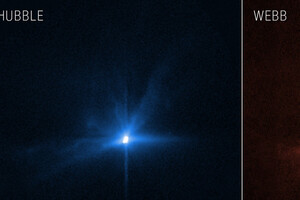This is indicated by images of the collision taken by the Hubble and James Webb telescopes.

Hubble and James Webb telescopes transmitted images of the collision of the DART apparatus with Dimorph, a satellite of asteroid Didim, to Earth. Thanks to this, scientists were able to determine that the collision was stronger than expected, reports Science Alert.
It is noted that the telescopes were deployed in the direction of Dimorph at the beginning of the week before the collision. In the images obtained with their help, you can see the cloud of dust surrounding the asteroid and its satellite, which appeared as a result of the impact.
Read also: Evidence of the asteroid that killed the dinosaurs has been found on the moon
According to Alan Sweetsimmons of King's University in Belfast, Hubble and James Webb images allow us to see what “happened within just a few kilometers from the asteroid and clearly see the material that flies away after the collision.”
An image taken by James Webb's Near Infrared Camera (NIRCam) four hours after the impact shows “plump-like plumes of material radiating from the center of the impact site.” Hubble images taken 22 minutes, five hours, and eight hours after impact show sprays of material flying away from the impact site of DART.
Ian Carnelly of the European Space Agency noted that the impact “ looks more serious than we expected.” “I was seriously worried that there would be nothing left of Dimorph,” he added.
The Hera mission, which is scheduled to launch in 2024, should arrive at the asteroid system in 2026. It is to study the crater, the diameter of which is expected to be about 10 meters. But according to Cornelli, it is likely to be much larger. “If there's a crater there at all, it's possible that a piece of the Dimorph was just torn off,” the scientist added.
But the true measure of the DART mission's success will be how much it managed to change the Dimorph's trajectory. If everything goes well, humanity can consider itself ready to change the trajectory of an asteroid that could be potentially harmful to Earth.
Recall that the launch of the DART mission took place on November 24, 2021, and was carried out with the help of a Falcon launch vehicle 9. On the night of September 27, it crashed into Dimorph at a speed of about 23,760 kilometers per hour. It is expected that the collision should change the trajectory of the satellite around the parent body.
Related video
The binary system was discovered back in 1996. It consists of two celestial bodies: Didyma with a diameter of about 780 meters and Dimorph, whose diameter is estimated at 160 meters.




